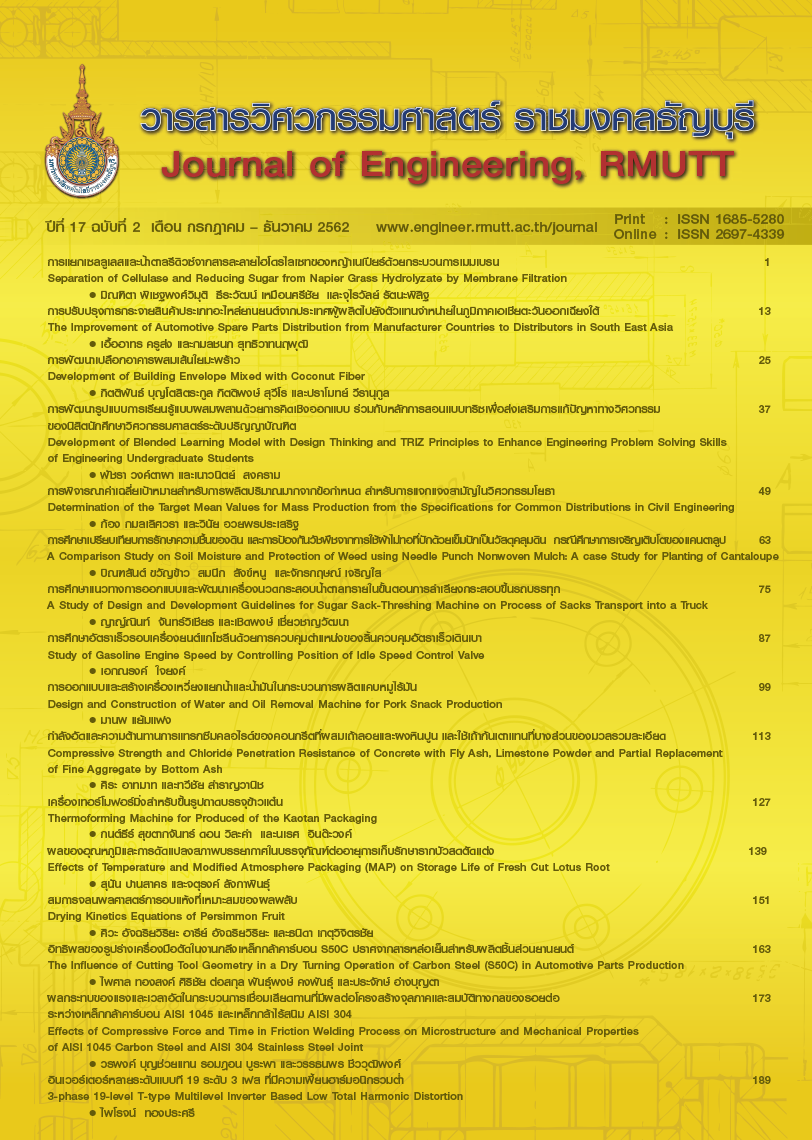Chloride penetration resistance, Electrical resistivity and compressive strength of concrete with fly ash, limestone powder and partial replacement of fine aggregate by bottom ash
Main Article Content
Abstract
The paper aims to study compressive strength, chloride penetration resistance and electrical resistivity of concrete with fly ash and bottom ash as partial replacement of fine aggregate. Ordinary Portland cement was used as a main cementitious material. The water to binder ratio was employed at 0.45 and 0.55. The fly ash to binder ratio was kept at 0.30 and 0.50. The limestone powder to binder ratio was kept 0.10. Fine aggregate was partially replaced by bottom ash at the replacement ratio of 0.10 and 0.30. Specimens were cured in tap water until 28, 56 and 91 days, then compressive strength and chloride penetration were performed. From the experimental results, it was found that concrete with bottom ash replacement ratio of 0.10 has higher compressive strength than concrete without bottom ash and concrete with bottom ash replacement of 0.30. Chloride penetration test concrete with bottom ash replacement of 0.10 and fly ash to binder ratio of 0.30 has the highest chloride penetration resistance. Moreover, concrete with 50% of cement replacement by fly ash and 10% of fine aggregate replacement by bottom ash has the best electrical resistivity at 510 days..
Article Details
The manuscript, information, content, picture and so forth which were published on Frontiers in engineering innovation research has been a copyright of this journal only. There is not allow anyone or any organize to duplicate all content or some document for unethical publication.
References
Poon C.S., Kon S.C., Lam L. Compressive strength chloride diffusivity and pore structure of high performance metakaolin and silica fume concrete. Construction and building material.2006,20:858-865.
Kunmongkol U. Rapid chloride penetration resistance and chloride threshold content of concrete of concrete containing fly ash and limestone powder and using bottom ash as partial replacement of fine aggregate [master’s thesis]. Chonburi: Burapha university; 2013. (in Thai)
Namchan S. The application of bottom ash as partially sand replacement for concrete under marine environment. Annual concrete conference 11th. 2016 Feb 17-19; Thailand. Nakhon Ratchasima ; 2016 (in Thai)
Hornain H., Marchand J., Duhot V., Moranville M. Diffusion of chloride ions in limestone filler blended cement pastes and motars. Cement and concrete research. 1995 Dec;25(8): 1667-1678.
Kasemchaisiri R., Tangtermsirikul S. A method to determine water retainability of porous fine aggregate for design and quality control of fresh concrete. Construction and building Materials. 2007; 21: 1322-1334.
ASTM C1202, Standard test method for electrical indication concrete’s ability to resist chloride ion penetration. 2004. Vol 4.02
ASTM C1556, Standard test method for determining the apparent chloride diffusion coefficient of cementitious mixtures by bulk diffusion. 2004. Vol 4.02
ASTM C1152, Standard test method for acid-soluble chloride in mortar and concrete. 2004. Vol 4.02
Chindaprasirt P., Jaturapitakkul C. and Sinsiri T. Effect of fly ash fineness on microstructure of blended cement paste. Construction and Building Materials. 2007; 21: 1534-1541


